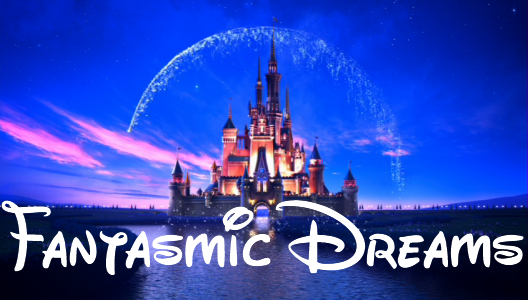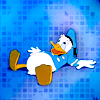Post by Donald Duck on Oct 23, 2008 16:31:33 GMT -8
Note: This is a review of a book. Unlike my movie reviews, I won’t detail the entire plot here. There will be some minor spoilers, but I won’t ruin anything big.
Introduction
“How would you describe the Disney parks?”
“Magic.”
Introduction
“How would you describe the Disney parks?”
“Magic.”
I’d have to agree. Whenever I visit Disneyland, especially with my family, the experience is never, ever dull. One day with my family was spent solely on shopping at Main Street U.S.A., and that was still a fun time. Heck, my mother was pick-pocketed once at the World of Disney store, and even that is a bizarrely fond memory that is looked back on with laughter and merriment. Sure, the park may seem to be made of magic when you’re a kid, but the older you become, the more you realize that Disneyland is more or less an illusion with old and new tricks. Despite the trickery, though, I would assert that Disneyland is still magical, because it’s just a shamelessly fun, amazing experience. … Not to mention a rather expensive experience (What does a single churro fetch nowadays? Like, five bucks?). The same goes to the other Disney parks, to certain degrees. One of my life goals is to visit Tokyo Disneyland before I die, but there’s also Disneyland Resort Paris, and the latest park in Hong Kong. I’m certain these are all magical experiences (and expensive), but there is one park I haven’t mentioned.
The park in Orlando, Florida was among the last projects Walt Disney worked on before his death, along with “The Jungle Book” and “The Happiest Millionaire” (both films were released in 1967). Mr. Disney died in 1966, before both films were released. During his final years, Walt had enthusiastically planned Disney World (which was later renamed Walt Disney World by his brother Roy, who outlived Walt).
Walt Disney World, designed to include an expanded Disneyland as well as several golf courses, would open nearly five years after Walt Disney’s death in 1971. (Just to clarify, the theme park with the Disneyland-like attractions and sections is known as the Magic Kingdom; Walt Disney World is the collective name of all theme parks in Orlando.) Exactly eleven years later, Walt Disney’s other idea, the Experimental Prototype Community of Tomorrow (EPCOT), opened to the excited public. 1989 saw the christening of Disney-MGM Studios, known today as Disney’s Hollywood Studios. The latest theme park to be added to Walt Disney World was Disney’s Animal Kingdom in 1998. Animal Kingdom is the largest single Disney theme park in the world, and is a zoologist’s heaven.
There are other sections and attractions in Walt Disney World, but I’ve covered the theme parks.
The Magic Kingdom: Similar to Disneyland in Anaheim, California, but larger and different in areas.
EPCOT: Science and cultures get together for one hell of a jamboree!
Disney’s Hollywood Studios: A movie-themed park where you can go and feel like a star… only without the drug overdoses, divorces and scandals!
Animal Kingdom: A theme park, a zoo, a safari with lions, tigers and… I’m not sure about bears, honestly.
So, there you go. Walt Disney World. To be honest, I’ve only visited that park twice, and I was sick during my second visit because a park’s bus driver coughed on me. Grumble, grumble. Because of my ill health I’ve never visited the Animal Kingdom, but Jake has! PM Goofy if you’re interested in details. Fortunately, I have visited the other parks: the Magic Kingdom (I prefer Disneyland, but to each their own), EPCOT and Hollywood Studios.
To make a long story short (too late), I’ve only visited Walt Disney World twice in my lifetime, and I freely admit that I don’t know as much about Walt Disney World as Disneyland, which is my favorite theme park in the world (Isn’t it weird how Disneyland is a single word, yet Walt Disney World consists of separate words?). Fortunately, even not knowing terribly much about Walt Disney World hasn’t stopped me from being mildly amused by The Kingdom Keepers by Ridley Pearson.
The Kingdom Keepers Review
An inside-joke, but a mildly engaging ride for those who are “in.”
An inside-joke, but a mildly engaging ride for those who are “in.”
Pros
- Interesting, creative use of fact and fiction
- A wide diversity of characters
- Engaging adventure overall; a good blend of science-fiction and thriller genres
- The use of a particular Disney character is a commendable touch
Cons
- Some of the original characters are stereotypical and/or bland
- Bizarre errors and typos
- The particular Disney character used seems out of character in spots
- You have to be at least somewhat knowledgeable about Disney theme parks to fully understand the story
A Pro or Con, Depending on Your Viewpoint
- The book ends abruptly in a slight cliffhanger
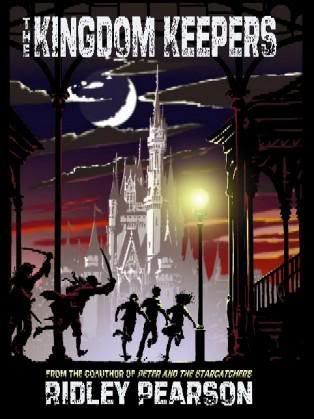
The story takes place in Walt Disney World, Florida, but the castle in the cover is in Tokyo Disneyland!
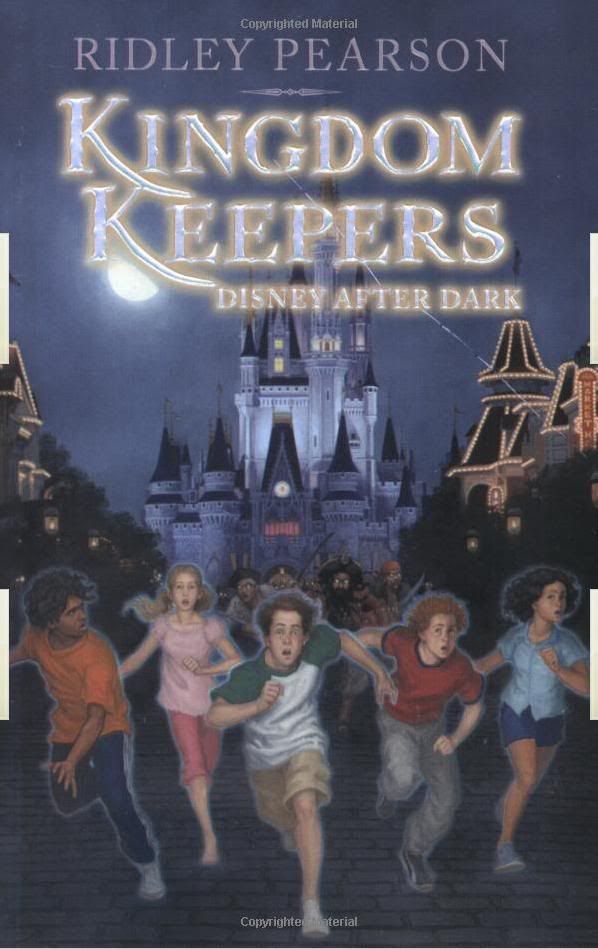
The newer cover.
The Kingdom Keepers is 325 pages in length, but it’s targeted to a young adult audience, so the family-friendly page layout guarantees that the experience will be brief to veteran readers. The book is written by Ridley Pearson, who co-wrote another Disney Editions book series: Peter and the Starcatchers, a prequel to “Peter Pan.” I haven’t read this book, let alone any of its sequels, but I was aware of its existence when I picked up The Kingdom Keepers.
At its best, The Kingdom Keepers is a mildly engaging adventure that puts the occasional smile on your face. At its worst, it is little more than published fan fiction, and with some glaring errors to boot.
The plot focuses on a group of five kids (Finn, Philby, Maybeck, Charlene and Willa), and their affiliation with Disney. They have been hired to record motion-captured holograms of themselves, and these holograms serve as Walt Disney World’s tour guides. (By now it’s obvious that this book takes place in an alternate reality.) At first things are normal, but then the children realize that when they sleep, they “cross over” to Walt Disney World’s Magic Kingdom, in partial human/partial hologram form. It is soon apparent that there is a reason to all of this: an elderly Imagineer named Wayne Kresky (who is allegedly based on a real Cast Member; this book’s character is a fictionalized version of himself) explains to the five kids that they are the only ones who can thwart the Overtakers, villainous characters within Walt Disney World that plan to take control of the park… and beyond. The storyline basically boils down to this: the DHIs must solve the riddle of The Stonecutter’s Quill, and stop the Overtakers from making a move.
The characters in this book vary in interest and personality. For the most part, they are stereotypical and are literally “Scooby-Doo in the Magic Kingdom.”
Meet the heroes! These kids are known as The Kingdom Keepers. They’re also known as the DHIs.
Finn – The coming-of-age central protagonist. Acknowledged leader of the five. Because he’s the main character, we focus on him more than some of the others.
Philby – The brains. An English kid, or an Australian kid, or a New Zealand kid. Whatever; he has an “accent.” Because he’s so smart, he somehow manages to find information about security cameras and infrared alarm systems via Google.
Charlene – The hot yet ditzy white girl. She spends the majority of the book whining and screaming. Despite her reluctance, she ultimately proves herself useful… kinda.
Willa – The geek. Of Native American or Asian descent. She is described as pretty but not “knockout gorgeous like Charlene.” Her role is a slight extension of Philby.
Maybeck – The token black kid. He works up an attitude on a frequent basis. His catchphrase is “You have to be kidding me.”
Each of the five kids has a gimmick, and this unfortunately results with stereotypes. Finn, Philby and Maybeck are perhaps the most fully developed characters, because they encounter several dangers and situations that test their resourcefulness and personalities. That leaves the girls, who are sadly only there to keep feminist critics at bay. Just like Rainier Wolfcastle’s goggles, the girls do nothing. Sure, Charlene is a Scrabble genius, but other than that she just screams, runs, and throws a hissy fit. Believe it or not, Willa has even less to do. She just helps Philby with finding information, and tags along when she can. Of the five kids, Charlene and Willa are the most forgettable; in fact, I’m having a hard time remembering some of the remarkable things they’ve done, and I just finished reading the book!
(EDIT: There is a chapter where Charlene and Willa are trapped in The Many Adventures of Winnie the Pooh ride, and the sprinkler system goes awry. Eventually, the girls are forced to find a way out before they drown. This is definitely the most interesting "girls-focused" chapter.)
Besides the DHIs, there are other supporting characters.
Wayne Kresky – The elderly Imagineer/Cast Member that serves as the group of five’s mentor and guide. He is one of the more interesting characters in the book, and one reason is his Mickey and Minnie slippers.
Amanda – A girl who ‘likes’ Finn, and it’s mutual. Despite being a secondary character, she gradually becomes more important as the story progresses.
Dillard – The fat, roly-poly friend of Finn. He serves no purpose other than to have pretty-faced girls render him a blithering, moronic slave.
Walt Disney – That’s right. Walt Disney is a character, albeit a deceased one. He is occasionally referenced, and is crucially important to the story. Since this is a fictional story, Walt Disney is more or less portrayed as a prophet.
Wayne may be interesting, but he, too, is a victim of stereotype; he speaks in cryptic clichés. With that said, this seems to be intentional. Amanda is far more interesting than both Charlene and Willa, and I’m shocked that she was merely a supporting character. Hopefully she’s a more major character in the sequel. Dillard is hardly worth mentioning; he only exists to show that Finn has a friend outside of the DHIs. Walt Disney being an unseen, dead character is a very interesting choice, and fortunately his preposterous prophecy fits with the preposterous story well.
(EDIT: There is one other major character that I intentionally did not mention when I first posted this review, because revealing much about her would be a spoiler. But since she is an even more major character in the sequel, I shall give you bare-bone facts about her. Her name is Jez, and she seems to have some connection with Amanda. She seems to be a nice enough girl at first, but for some reason she seems to have ties with a certain Disney villain...)
And let’s not forget the Overtakers!
Captain Blackbeard – The story’s minor, secondary villain. Hell, calling him a "minor, secondary villain" is still too generous, because he only appears in a single chapter. He combats Finn early in the book, when Finn catches the captain and his audio-animatronic crew to steal cars and laser guns from Buzz Lightyear Space Ranger Spin.
Maleficent – The story’s primary antagonist. She longs to overtake Walt Disney World, and relentlessly antagonizes the kids after she’s introduced, nearly killing them in several moments.
“Whoa, really? Maleficent is the villain? Cool!” Yeah, that’s what I thought at first, but to be honest I don’t think this is the Maleficent we know. If she is meant to be, though, then Mr. Pearson has taken considerable liberties with the character: in this book, Maleficent 1) drives a car, 2) rides a motorcycle, 3) casts a chilling cold wherever she goes, and her powers can only fetter in cold areas, 4) has long-black hair when she’s not wearing her headdress, and 5) at one point exclaims, “Aaahh! I needed that!” Yeeeaaahhh… not exactly the Maleficent we know. My guess, though, is that this is intentional—my theory is that it’s not the Maleficent from “Sleeping Beauty,” but rather a Cast Member from Hell. Whatever the intention, Maleficent is the story’s antagonist, and while some of her dubious actions are baffling, she is more or less as menacing and evil as she should be.
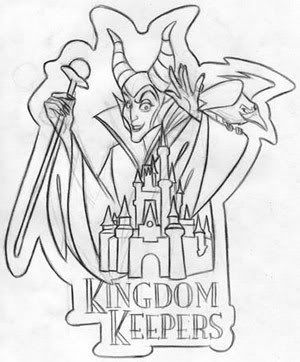
A sketch of a design that would eventually be made into a pin.
Regrettably, The Kingdom Keepers is plagued by several errors, besides a few typos. For example, Mr. Pearson mistakes Br’er Fox for a wolf (he also doesn’t wear a cowboy hat, for crying out loud), and “Fantasmic!” is erroneously referred to as “Fantasmics”. These mistakes signal that Mr. Pearson, bless his heart, is not as “into” Disney as you and I. Of course, you can’t blame a guy for trying… though next time he should try harder and not make such cringe-inducing errors!
Relax! I’ll be nice to the author now. Thank you, Mr. Pearson, for voluntarily going about the Herculean task of taking Walt Disney World and meshing it with a fictional story of wonder and danger. Sure, it’s not perfect, and it’s not the best Disney-related book I’ve ever read, but it’s engaging. My favorite chapter takes place in it’s a small world (erroneously spelled as It’s a Small World in the book), where Finn, Philby, Maybeck, Charlene and Willa are attacked by the dolls. Yes. You read that right, and believe me, it’s hilarious.
The detail and attention given to the Magic Kingdom is perhaps the book’s best aspect. While liberties were taken (I don’t mind, considering that this is a work of fiction), the attractions and locations were brought front and center with tender loving care. The “Partners” statue; Cinderella’s Castle; Tom Sawyer Island; The Many Adventures of Winnie the Pooh (also an interesting chapter); Space Mountain; Main Street, U.S.A.; Big Thunder Mountain Railroad; Splash Mountain; The Haunted Mansion; Pirates of the Caribbean… it’s all here, and it all somehow meshes with the fictional storyline perfectly. Disney characters are also referenced, though not nearly as much as tangible attractions.
This book is out of date, though. Virtual Magic Kingdom (VMK) plays a major role in this book, to the point where it’s gratuitous advertising. Sadly, VMK is no longer functioning; it closed its gates forever in late May, 2008. As with the Magic Kingdom, liberties were taken with VMK, but it fits the context of the story.
Here’s my avatar in VMK. Gosh, how I miss that game.
How much one would enjoy The Kingdom Keepers ultimately depends on how much one is familiar with Disney, especially Walt Disney World. The fact that one has never visited the theme park shouldn’t stop one from enjoying this book, but some knowledge is mandatory. The book does explain the attractions in detail, but there is some room left for previously conceived knowledge. Some of the humor does fall flat (there is a single flatulence joke, which is of course unnecessary and undesirable), and some of the characters are bland.
Despite my criticism, I did enjoy The Kingdom Keepers. I laughed on at least one occasion, I smiled numerous times, I cringed at a few parts (thankfully, there weren’t enough to ruin the overall experience), and I shouted “WTF?” on one occasion, near the end. The Kingdom Keepers is absolutely worth reading to those who are 1) Disney freaks such as myself, 2) somewhat familiar with Disney theme parks, and 3) willing to turn their brains off for a while and enjoy a mildly engaging ride.
I give The Kingdom Keepers a 7 out of a possible 10.
